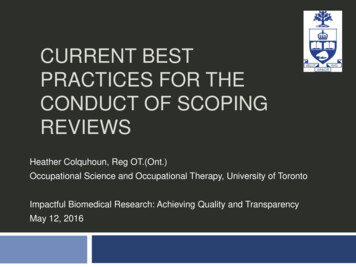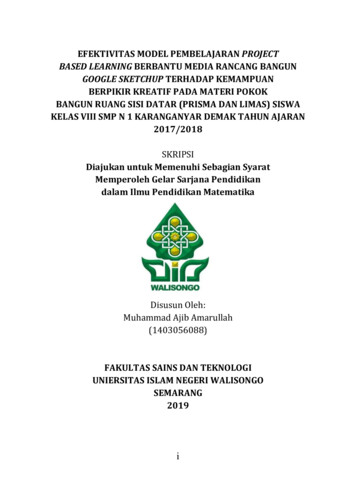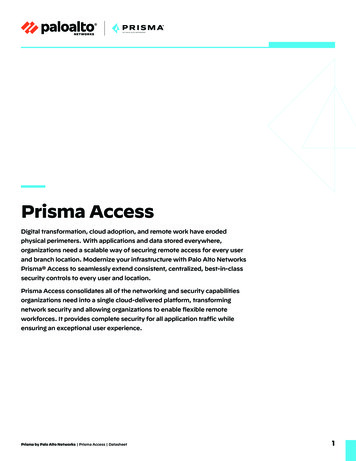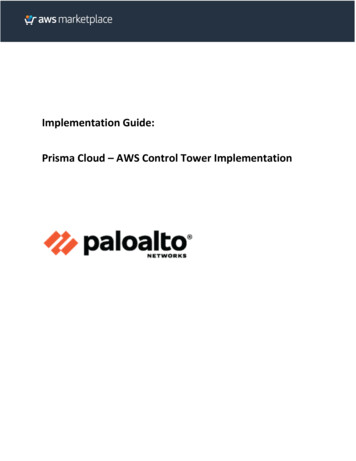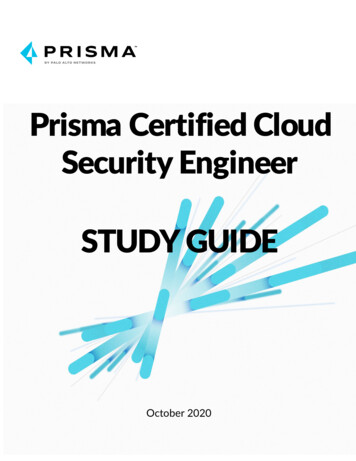
Transcription
This is a repository copy of PRISMA Extension for Scoping Reviews (PRISMA-ScR) :Checklist and Explanation.White Rose Research Online URL for this on: Accepted VersionArticle:Tricco, Andrea C, Lillie, Erin, Zarin, Wasifa et al. (25 more authors) (2018) PRISMAExtension for Scoping Reviews (PRISMA-ScR) : Checklist and Explanation. Annals ofInternal Medicine. pp. 467-473. ISSN s deposited in White Rose Research Online are protected by copyright, with all rights reserved unlessindicated otherwise. They may be downloaded and/or printed for private study, or other acts as permitted bynational copyright laws. The publisher or other rights holders may allow further reproduction and re-use ofthe full text version. This is indicated by the licence information on the White Rose Research Online recordfor the item.TakedownIf you consider content in White Rose Research Online to be in breach of UK law, please notify us byemailing eprints@whiterose.ac.uk including the URL of the record and the reason for the withdrawal terose.ac.uk/
1PRISMA Extension for Scoping Reviews (PRISMA-ScR): Checklist and2Explanation3Andrea C Triccoa,b*Email: triccoa@smh.ca4Erin LilliebEmail: lilliee@smh.ca5Wasifa ZarinbEmail: zarinw@smh.ca6Kelly K O’Brienc,d,eEmail: kelly.obrien@utoronto.ca7Heather ColquhounfEmail: heather.colquhoun@utoronto.ca8Danielle LevacgEmail: d.levac@northeastern.edu9David MoherhEmail: dmoher@ohri.ca10Micah D J Petersi,jEmail: micah.peters@unisa.edu.au11Tanya HorsleykEmail: thorsley@rcpsc.edu12Laura WeekslEmail: lauraw@cadth.ca13Susanne HempelmEmail: susanne hempel@rand.org14Elie A AklnEmail: ea32@aub.edu.lb15Christine ChangoEmail: christine.chang@ahrq.hhs.gov16Jessie McGowanpEmail: jmcgowan@uottawa.ca17Lesley StewartqEmail: lesley.stewart@york.ac.uk18Lisa HartlingrEmail: hartling@ualberta.ca19Adrian AldcroftsEmail: aaldcroft@bmj.com20Michael G WilsontEmail: wilsom2@mcmaster.ca21Chantelle GarrittyhEmail: cgarritty@ohri.ca22Simon Lewinu,vEmail: simon.lewin@fhi.no23Christina M GodfreywEmail: godfreyc@queensu.ca1
24Marilyn T MacdonaldxEmail: marilyn.macdonald@dal.ca25Etienne V LangloisyEmail: langloise@who.int26Karla Soares-WeiserzEmail: ksoares-weiser@cochrane.org27Jo MoriartyaaEmail: jo.moriarty@kcl.ac.uk28Tammy CliffordlEmail: tammyc@cadth.ca29Özge Tunçalpab,acEmail: tuncalpo@who.int30Sharon E Strausa,adEmail: sharon.straus@utoronto.ca3132Author Affiliations33a34Hospital, 209 Victoria Street, East Building, Toronto, Ontario, M5B 1T8, Canada35b36College Street, 6th floor, Toronto, Ontario, M5T 3M7, Canada37c38Toronto, Ontario, M5G 1V7, Canada39d40155 College Street, 4th Floor, Toronto, Ontario, M5T 3M6, Canada41e42Suite 160, Toronto, Ontario, M5G 1V7, Canada43f44160 - 500 University Ave, Toronto, Ontario, M5G 1V7, CanadaKnowledge Translation Program, Li Ka Shing Knowledge Institute, St. Michael’sEpidemiology Division, Dalla Lana School of Public Health, University of Toronto, 155Department of Physical Therapy, University of Toronto, 160-500 University Ave,Institute of Health Policy, Management and Evaluation (IHPME), University of Toronto,Rehabilitation Sciences Institute (RSI), University of Toronto, 500 University Avenue,Department of Occupational Science & Occupational Therapy, University of Toronto2
45g46of Health Sciences, Northeastern University, 360 Huntington Ave, Boston,47Massachusetts 02115, United States48h49Smyth Road, PO BOX 201B, Ottawa, Ontario, K1H 8L6, Canada50i51Australia52j53University of South Australia, Adelaide, South Australia, 5000, Australia54k555N8, Canada56l57Suite 600, Ottawa, Ontario, K1S 5S8, Canada58m59States60n61floor, American University of Beirut, Riad El-Solh, Beirut, Lebanon62o63Rockville, MD, 20857, United States64p65Ottawa, Ontario, K1H 8M5, Canada66q675DD, United KingdomDepartment of Physical Therapy, Movement & Rehabilitation Science, Bouvé CollegeCentre for Journalology, Ottawa Hospital Research Institute, The Ottawa Hospital, 501Joanna Briggs Institute, The University of Adelaide, Adelaide, South Australia, 5005Rosemary Bryant AO Research Centre, Sansom Institute for Health Research,The Royal College of Physicians and Surgeons, 774 Echo Drive, Ottawa, Ontario, K1SCADTH (Canadian Agency for Drugs and Technologies in Health), 865 Carling Ave,RAND Corporation, 1776 Main Street, Santa Monica, California, 90401-3208, UnitedDepartment of Internal Medicine, Faculty of Medicine, Gefinor Center, Block B, 4thAgency for Healthcare Research and Quality (AHRQ), 5600 Fishers LaneDepartment of Medicine, University of Ottawa, Roger Guindon Hall, 451 Smyth Rd,Centre for Reviews and Dissemination, University of York, Heslington, York, YO103
68r6911405-87 Avenue, Edmonton, Alberta, T6G 1C9, Canada70s71Kingdom72t731280 Main St West, Hamilton, Ontario, L8S 4K1, Canada74u75v76Zyl Drive, Tygerberg, Cape Town, South Africa77w78University School of Nursing, 992 University Avenue, Barrie Street, Kingston, Ontario,79K7L 3N6, Canada80x81Halifax, Nova Scotia, B3H 4R2, Canada82y83Appia 20, 1211 Geneva, Switzerland84z85SW1Y 4QX, United Kingdom86aa872LS, United Kingdom88ab89Development and Research Training in Human Reproduction (HRP), World Health90Organization, 20 Avenue Appia, 1211 Geneva, SwitzerlandDepartment of Pediatrics, Faculty of Medicine and Dentistry, University of Alberta,BMJ Open Editorial Office, BMA House, Tavistock Square, London, WC1H 9JR, UnitedDepartment of Health Research Methods, Evidence, and Impact, McMaster University,Norwegian Institute of Public Health, PO Box 4404 Nydalen N-0403, Oslo, NorwayHealth Systems Research Unit, South African Medical Research Council, Francie vanQueen’s Collaboration for Health Care Quality: A JBI Centre of Excellence, Queen’sSchool of Nursing, Dalhousie University, PO Box 15000, 5869 University Avenue,Alliance for Health Policy and Systems Research, World Health Organization, AvenueCochrane Editorial Unit, Cochrane, St Albans House, 57-59 Haymarket, London,Social Care Workforce Research Unit, King's College London, Strand, London, WC2RUNDP-UNFPA-UNICEF-WHO-World Bank Special Programme of Research,4
91ac92Avenue Appia 20, 1211 Geneva, Switzerland93ad94Toronto, Ontario, M5S 1A1, CanadaDepartment of Reproductive Health and Research (RHR), World Health Organization,Department of Geriatric Medicine, University of Toronto, 27 Kings College Circle,9596*Correspondence and requests for single reprints:97Dr. Andrea C. Tricco, PhD98Scientist, Knowledge Translation Program,99Li Ka Shing Knowledge Institute, St. Michael’s Hospital,100209 Victoria Street, East Building, Toronto, Ontario, M5B 1W8, Canada101Phone : 416-864-6060, Fax : 416-864-5805, Email : triccoa@smh.ca102103Keywords: knowledge synthesis, scoping reviews, reporting guidelines, research104methodology105Running Title: The PRISMA-ScR statement106Trial registration - EQUATOR registration: g-guidelines-under-development/#55108Word Count: 147/200 (Abstract); 2583/3,500 words (Manuscript); 59/75 References; 1109Figure; 1 Table; 3 Supplements5
110ABSTRACT111Scoping reviews, a type of knowledge synthesis, follow a systematic approach to map112evidence on a topic; identify main concepts, theories and sources; and determine where113the gaps are. Though increasing in numbers, the methodological quality and reporting114quality of scoping reviews need improvement. This document presents the Preferred115Reporting Items for Systematic Reviews and Meta-Analyses extension for scoping116reviews (PRISMA-ScR) checklist and explanation. Developed by a 26-member expert117panel according to published guidance by the EQUATOR (Enhancing the QUAlity and118Transparency Of health Research) Network, the checklist contains 20 essential items119plus 2 optional items. A rationale, along with an example of good reporting, is provided120for each item. The intent of the PRISMA-ScR is to help readers, including researchers,121publishers, commissioners, policy-makers, healthcare providers, guideline developers,122and patients/consumers develop a greater understanding of relevant terminology, core123concepts and key items to report for scoping reviews.1246
1251. INTRODUCTION126Scoping reviews can be conducted to meet various objectives. They may examine the127extent (i.e., size), range (i.e., variety) and nature (i.e., characteristics) of the evidence on128a topic or question; determine the value of undertaking a systematic review; summarize129findings from a body of knowledge that is heterogeneous in terms of methods or130discipline; or identify gaps in the literature to aid planning and commissioning of future131research (1, 2). A recent scoping review by members of our team showed that while the132number of scoping reviews in the literature is increasing steadily, evidence suggests133that both their methodological quality and reporting quality need to improve to facilitate134complete and transparent reporting (1). Results from our survey on scoping review135terminology, definitions and methods revealed a lack of consensus on how to conduct136and report scoping reviews (3).137The Joanna Briggs Institute (JBI) published guidance for the conduct of scoping reviews138in 2015 (4) (which was updated in 2017) (5), based on earlier work by Arksey and139O’Malley (6) and Levac et al. (7). However, a reporting guideline for scoping reviews140currently does not exist.141Reporting guidelines outline a minimum set of items to include in research reports and142have been shown to increase methodological transparency and uptake of research143findings (8, 9). Although a reporting guideline exists for systematic reviews, the144Preferred Reporting Items for Systematic Reviews and Meta-Analyses (PRISMA)145Statement (10), scoping reviews serve a different purpose than systematic reviews (11).146Systematic reviews are useful for answering clearly defined questions (such as, Does147this intervention improve specified outcomes when compared to a given comparator in7
148this population?), whereas scoping reviews are useful for answering much broader149questions (such as, What is the nature of the evidence for this intervention? Or What is150known about this concept?). Given the difference in objectives, and therefore, in the151methodological approach (e.g., presence vs. absence of a risk of bias assessment or152meta-analysis), the reporting items considered to be essential for systematic reviews153would differ for scoping reviews – i.e., some PRISMA items may not be appropriate,154while other important considerations may be missing (12-14). We deemed that a155PRISMA extension for scoping reviews is needed to provide reporting guidance for this156specific type of knowledge synthesis. This extension is also intended to be applicable to157evidence maps (15, 16), which share similarities with scoping reviews, and involve a158systematic search of a body of literature to identify knowledge gaps, with a visual159representation of results (e.g., a figure, graph, etc.).1601612. METHODS162The PRISMA extension for scoping reviews (hereafter, the PRISMA-ScR) was163developed according to published guidance by the EQUATOR (Enhancing the QUAlity164and Transparency Of health Research) Network for the development of reporting165guidelines (9).1662.1 Protocol, advisory board and expert panel167Our protocol was drafted by the research team and revised, as necessary, by the168advisory board prior to being listed as a reporting guideline on the EQUATOR (17) and169PRISMA (18) websites. The research team included two leads (ACT, SES) and two8
170research coordinators (EL, WZ); all of whom did not participate in the scoring exercises,171and a 4-member advisory board (KOB, HC, DL, DM) with extensive experience with172scoping reviews and/or the development of reporting guidelines. We aimed to have a173representative expert panel in terms of geography and stakeholder type; including174individuals with experience in the conduct, dissemination, or uptake of scoping reviews.1752.2 Survey development and round 1 of Delphi176The initial step to developing the Delphi survey via Qualtrics (an online survey platform)177(19) involved identifying potential modifications to the original 27-item PRISMA178checklist. The modifications were based on a research program carried out by members179of the advisory board to better understand scoping review practices (1, 3, 20) and180included: a broader research question and literature search strategy, optional risk of181bias assessment and consultation exercise (whereby relevant stakeholders contribute to182the work, as described in the Arksey and O’Malley framework (6)), and the inclusion of a183qualitative analysis. For round 1 of scoring, we prepared a draft of the PRISMA-ScR184(see Supplement 1) and asked expert panel members to rate the extent to which they185agreed with the inclusion of the list of items in using a 7-point Likert scale (1 entirely186disagree, 2 mostly disagree, 3 somewhat disagree, 4 neutral, 5 somewhat agree,1876 mostly agree, 7 entirely agree). Each survey item included an optional text box188where comments about the respective item(s) could be provided. The research team189pilot-tested the survey for content and clarity prior to administering it, and we also sent190bi-weekly reminders to optimize participation.9
1912.3 Survey analysis192An 85% consensus rule was selected a priori to signify agreement amongst the expert193panel, to be conservative. This rule required that at a minimum, 85% of the panel mostly194or entirely agreed (i.e. corresponding to the scoring values of 6 or 7 on the Likert scale195used for each of the survey items) with the inclusion of the item in the PRISMA-ScR. If196less than 85% agreement was observed, we considered the item to be discrepant. This197standard was used for all three rounds of scoring to inform the final checklist. For ease198and consistency with how the survey questions were worded, we did not include a199provision for agreement on exclusion (i.e., 85% scoring values of 1 or 2 on the Likert200scale). We summarized all of the submitted comments to help explain the scorings and201identify any issues. For the analysis, the results were stratified by group (i.e., in-person202meeting vs. online, hereafter e-Delphi participants) given the possibility that discrepant203items could differ between the arms.2042.4 In-person arm (round 2 of Delphi)205We established the Chatham House rule (21) at the beginning of the meeting, whereby206participants are free to use information that is shared but may not reveal the identity or207the affiliation of the speaker. Expert panel members were provided the following: their208individual results, the overall group distribution, median and interquartile range and a209summary of the JBI methodological guidance (4), as well as preliminary feedback from210the E-Delphi arm (described below). These data were used to generate and inform the211discussion about each of the discrepant items from round one. ACT and SES facilitated212the discussion using a modified nominal group technique (22), a consensus-building10
213method and panel members were subsequently asked to re-score the discrepant items214using sli.do (23), a live audience-response system in a format that resembled the round215one survey. For items that failed to meet the threshold for consensus, working groups216were assembled (described below). The meeting was audio-recorded and transcribed217using Transcribe Me (24), and 3 note-takers independently documented the main218discussion points. The transcript was annotated to complement a master summary of219the discussion points, which was compiled using the 3 note-takers’ files.2202.5 E-Delphi arm (round 2 of Delphi)221Those who were unable to attend the in-person meeting participated via an online222discussion exercise using Conceptboard (25), a visual collaboration platform that allows223users to provide feedback on ‘whiteboards’ in real-time. We presented the discrepant224items from round one as a single board in Conceptboard (25) with questions (e.g., “After225reviewing your survey results with respect to this item, please share why you rated this226item the way you did”) assigned to participants as tasks, to facilitate the discussion. E-227Delphi panel members were provided with the same materials as those distributed at228the meeting and were encouraged to respond to others’ comments and interact through229a chat feature. The second round of scoring was conducted in Qualtrics using a similar230format as in round one. We shared a summary of the Conceptboard (25) discussion, as231well as the annotated meeting transcript and master summary document so that232participants could learn about the perspectives of the in-person group before re-scoring.11
2332.6 Working groups and round 3 of Delphi234To enable panel-wide dialogue and refine the checklist items prior to the final round of235scoring, we created working groups that collaborated by teleconference and email.236Their task was to discuss the discrepant items; in terms of the key issues and237considerations (relating to both concepts and wording) that had been raised in earlier238stages, across both arms. To unite the data from the two arms, we conducted a third239round of scoring using Qualtrics (19). This step involved the full panel scoring an240updated list of items that had failed to reach consensus in the first two rounds across241both arms, with the suggested modifications (relating to both concepts and wording)242from all previous stages incorporated.2432.7 Interactive workshop (testing)244A workshop led by ACT and facilitated by members of the advisory board/expert panel245(SES, CMG, CG, TH, MTM, and MDJP) was held as part of the Global Evidence246Summit in Cape Town, South Africa in September 2017. The PRISMA-ScR was applied247to a scoping review on a health-related topic (26) by participants (e.g., researchers,248scientists, policy makers, managers, and students) to test the checklist .2493. RESULTS2503.1 Expert panel251A total of 37 individuals were invited to participate – of these, 31 people completed252round 1 and 24 completed all 3 rounds of scoring. Results of the modified Delphi,12
253including the number of items that met agreement at each stage are presented in Figure2541.2553.2 Round 1 of Delphi256For the in-person arm, which involved 16 individuals, 9 of the 27 items reached257agreement. For the discrepant items, agreement ranged from 56% for item 15 (risk of258bias) to 81% for items 3 (rationale), 16 (additional analyses), 20 (results of individual259sources) and 23 (additional analyses). For the E-Delphi arm, which involved 15260individuals, 8 of the 27 items met the 85% agreement threshold. For the discrepant261items, agreement ranged from 40% for item 12 (risk of bias) to 80% for items 3262(rationale), 25 (limitations) and 26 (conclusions).2633.3 In-person meeting and round 2 of Delphi264The 16 panel members who attended the in-person meeting in Toronto on November26529th, 2016 were largely from North America, along with others from Australia, Lebanon,266and the United Kingdom. Of the 18 discrepant items from round 1, 11 were re-scored267after discussion. All reached the 85% threshold of agreement, except for one – item 7,268information sources, which had 83% agreement. For the remaining seven items, the269group felt that notable changes to the items were required, which formed the basis of270action by the working groups.2713.4 E-Delphi online discussion and round 2 Delphi272Fifteen panel members were invited to participate in the online discussion exercise,273from countries including Canada, United Kingdom, Switzerland, Norway, and South13
274Africa. Overall, 50% of panelists participated in at least one discussion on275Conceptboard (25) (7/14) and 1 dropped out. Eleven individuals completed the second276scoring exercise of the 19 discrepant items, whereby 5 items reached 85% agreement.2773.5 Working groups and round 3 of Delphi278There were 6 working groups (with one call per group), ranging in size from three to279eight participants, with an average of five people per group. For round 3 of the Delphi,280the 11 items that reached consensus during either round one or round two across both281the in-person and E-Delphi arms were not included. The survey focused on the282remaining 16 items that failed to reach consensus across both arms, to ensure that283decisions made by one arm did not take precedence over the other.284A total of 27 people were invited to participate in round 3 of the Delphi; 16 from the in-285person meeting arm and 11 from the E-Delphi arm. Overall, 24 out of 27 completed the286final round of scoring and 3 individuals withdrew (2 from the in-person arm and 1 from287the E-Delphi). Two of the 16 applicable items failed to meet the 85% agreement288threshold; items 10 (data collection process) and 15 (risk of bias across studies). Item28915 was subsequently removed from the checklist, though item 10 was retained but290revised to exclude the optional consultation exercise step described by Arksey and291O’Malley and Levac et al., which was the source of the disagreement. Furthermore, it292was decided that the consultation exercise could be considered a knowledge translation293activity, which could be conducted for any type of knowledge synthesis.14
2943.6 Interactive workshop (testing)295A total of 30 participants attended an interactive workshop at the Global Evidence296Summit in September 2017 in Cape Town, South Africa, where minor revisions were297suggested for wording of the items.2983.7 PRISMA-ScR checklist299The final checklist, with 20 items plus two optional items, is presented in Table 1. It300consists of 10 items that reached agreement in rounds 1 and 2 (1,3,5,6,8,9,17,25-27),301along with the 10 items that were agreed upon in round 3 (2,4, 7,10,11,14,18,20,21,24).302Five items from the original PRISMA were deemed not relevant. They included: items30313 (summary measures, excluded after round 1) and the following 4 items, which were304excluded after round 3: 15 (risk of bias across studies), 16 (additional analyses), 22 (risk305of bias across studies results), and 23 (additional analyses results). See Figure 1 for an306illustration of the process. In addition, because scoping reviews can include many307different types of evidence (e.g., documents, blogs, websites, studies, interviews,308opinions) and are not conducted to examine the risk of bias of the included sources,309items 12 (risk of bias in individual studies) and 19 (risk of bias within studies results)310from the original PRISMA are treated as optional in the PRISMA-ScR.3113123.8 PRISMA-ScR Explanation and Elaboration313Each of the PRISMA-ScR checklist items is elaborated upon in Supplement 2. In this314document, each item is defined and accompanied by examples of good reporting from15
315existing scoping reviews to provide authors with additional guidance on how to use the316PRISMA-ScR.3174. DISCUSSION318The PRISMA-ScR is intended to provide guidance on the reporting of scoping reviews.319To develop this PRISMA extension, we adapted the original PRISMA Statement and320made the following revisions: five items were removed (as they were deemed not321relevant to scoping reviews), two items were deemed optional, and the wording was322modified for all of the items. Our reporting guideline is consistent with the JBI guidance323for scoping reviews, as the JBI guidance is detailed and highlights the importance of324methodological rigor in the conduct of scoping reviews. We hope that the PRISMA-ScR325will improve the reporting of scoping reviews and increase their relevance for decision-326making, and that adherence to our reporting guideline will be evaluated in the future,327which will be critical to measure its impact.328329The PRISMA-ScR will be housed on the websites of the EQUATOR Network’s library of330reporting guidelines and the Knowledge Translation Program of St. Michael’s Hospital331(27). To promote its uptake, we will create 1-minute YouTube videos to outline how to332operationalize each of the items; offer webinars for organizations that conduct scoping333reviews, and create 1-page tip sheets for each item. In the future, we will consider334creating an automated email PRISMA-ScR dissemination tool, as well as an online tool335similar to Penelope, which verifies manuscripts for completeness and provides feedback336to authors as they prepare to submit their work to the BMJ Open journal (28). We will337share the PRISMA-ScR widely within our networks, including the Alliance for Health16
338Policy and Systems Research, the World Health Organization (WHO) (29) and the339Global Evidence Synthesis Initiative (30). We will also l collect and review readers’340suggestions to improve uptake of the PRISMA-ScR via an online feedback form on the341Knowledge Translation Program of St. Michael’s Hospital’s website (27).342343Study Protocol: Available at EQUATOR and PRISMA websites.344Data Set: Available from corresponding author.17
345CONTRIBUTIONS346ACT developed the original idea, oversaw all stages of the project, facilitated the in-347person meeting, wrote the manuscript draft, and is the guarantor for this manuscript. EL348wrote sections of the manuscript and coordinated and operationalized all stages of the349project with WZ. KOB, HC, DL, DM, MDJP, TH, LW, SH, EAA, CC, JM, LS, LH, AA,350MGW, CG, SL, CMG, MTM, EVL, KS, JM, TC, and OT completed round 1 of scoring.351KOB, HC, DL, MDJP, TH, LW, SH, EAA, CC, JM, LS, LH, AA, and MGW attended the352in-person meeting and completed round 2 of scoring. CG, SL, CMG, EVL, and KS353provided feedback on Conceptboard. DM, CG, SL, CMG, MTM, EVL, KS, JM, TC, and354OT completed the E-Delphi round 2 of scoring. KOB, HC, DL, DM, MDJP, TH, LW, SH,355EAA, CC, JM, LS, LH, AA, CG, SL, MTM, and KS participated in the working group356discussions. KOB, HC, DL, DM, MDJP, TH, LW, SH, EAA, CC, JM, LS, LH, AA, MGW,357CG, SL, CMG, MTM, EVL, KS, JM, TC, and OT completed the final round of scoring.358SES developed the original idea, oversaw all stages of the project and facilitated the in-359person meeting. All authors critically reviewed the manuscript and approved the final360version.361ACKNOWLEDGEMENTS362We would like to thank the following individuals:363Susan Le for supporting the coordination of the project and formatting the manuscript.364Anna Lambrinos for participating in round 1 of scoring and attending the in-person365meeting.366Mai Pham for participating in round 1 of scoring and attending the in-person meeting.18
367Lisa O’Malley for participating in round 1 of scoring and in the E-Delphi round 2 of368scoring.369Peter Griffiths for participating in round 1 of scoring and providing feedback on370Conceptboard.371Charles Shey Wiysonge for participating in round 1 of scoring and providing feedback372on Conceptboard.373Jill Manthorpe for participating in round 1 of scoring.374Mary Ann McColl for participating in round 1 of scoring.375Assem M Khamis for assisting with the identification of examples for the Explanation376and Elaboration document.377Melissa Chen for providing administrative support for the in-person meeting.378Jessica Comilang for providing administrative support for the in-person meeting.379Meghan Storey for providing administrative support for the in-person meeting.380FUNDING381This work was supported by a Knowledge Synthesis grant from the Canadian Institutes382of Health Research (CIHR) [grant # KRS 144046]. This funding body had no role in383designing the study, in collecting, analyzing and interpreting the data, in writing this384manuscript, and in deciding to submit it for publication. ACT is funded by a Tier 2385Canada Research Chair in Knowledge Synthesis. KOB was supported by a Canadian386Institutes of Health Research (CIHR) New Investigator Award. SES is funded by a Tier 1387Canada Research Chair in Knowledge Translation.19
388COMPETING INTERESTS389DM led the development of PRISMA, has been involved in the development of several390PRISMA extensions, is an executive member of the EQUATOR Network, and is the391director of the Canadian EQUATOR Centre. MDJP is the chair of the Joanna Briggs392Institute Working Group for Scoping Review Methodology and is the lead author of the393Joanna Briggs Institute Scoping Review Guidance chapters and articles. CMG is a394contributing author on the Joanna Briggs Institute manuscript Guidance for conducting395systematic scoping reviews. KS is a full-time employee of Cochrane. All other authors396have no potential (or perceived) conflicts of interest to declare. SES is an associate397editor for the Annals of Internal Medicine; she was not involved in the peer review398process or decision-making of the manuscript.399ETHICAL APPROVAL400Research ethics approval (REB 16-176) for this study was granted by the St. Michael’s401Hospital Research Ethics Board on August 15th, 2016.402DATA SHARING403The results from the three rounds of scoring are available from the corresponding404author upon reasonable request.405TRANSPARENCY STATEMENT406The lead author affirms that the manuscript is an honest, accurate, and transparent407account of the study being reported; that no important aspects of the study have been20
408omitted; and that any discrepancies from the study as planned (and, if relevant,409registered) have been explained.410SUPPLEMENTARY FILES411Supplement 1: PRISMA-ScR round 1 survey (with information sheet)412Supplement 2: The PRISMA Extension for Scoping Reviews (PRISMA-ScR):413Explanation and Elaboration414Supplement 3: Letters of Permission415FIGURES416Figure 1: Methods flow417TABLES418Table 1: PRISMA-ScR checklist21
419420Table 1: PRISMA-ScR Ch
1 1 PRISMA Extension for Scoping Reviews (PRISMA-ScR): Checklist and 2 Explanation 3 Andrea C Triccoa,b* Email: triccoa@smh.ca 4 Erin Lillieb Email: lilliee@smh.ca 5 Wasifa Zarinb Email: zarinw@smh.ca 6 Kelly K O'Brienc,d,e Email: kelly.obrien@utoronto.ca 7 Heather Colquhounf Email: heather.colquhoun@utoronto.ca 8 Danielle Levacg Email: d.levac@northeastern.edu
